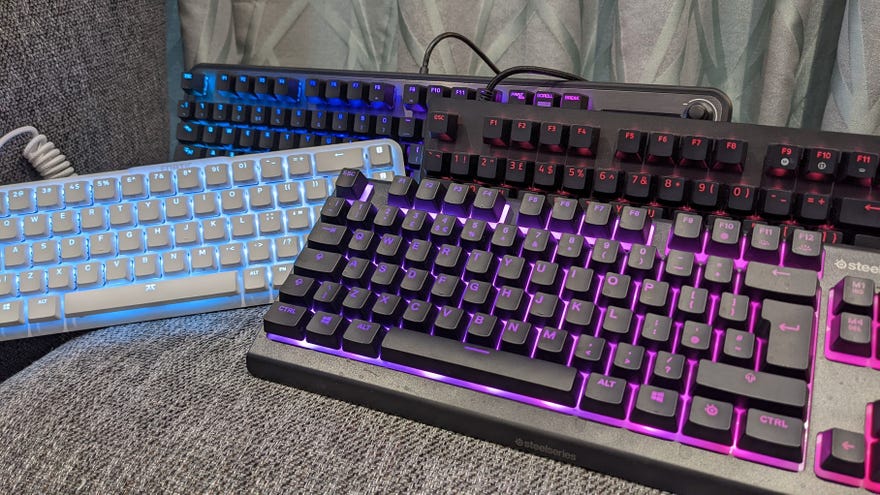Best gaming keyboard 2023: the top mechanical and wireless keyboards for gaming
Our favourite gaming keyboard picks for all budgets
There’s an almost comforting longevity behind the best gaming keyboards. While the graphics card market snaps its own back trying to pile up mega-expensive GPUs that will themselves become obsolete in 24 months, a quality keyboard can keep its place on your desk for years and years to come. Especially if you go for a hardy mechanical keyboard, though there are some good, budget-friendly membrane and hybrid options to choose from as well.
This right here is a list of our favourites, from the best in full-size RGB opulence to compact tenkeyless and 60% gaming keyboards. With a few detours through the finest wireless, customisable, and optical-mechanical specialists, of course.
If you’re not sure which style is best for you, try to think about not just how much cash you’re willing to part with, but also the specific features and design qualities you really want. If you want to play button-hogging MMOs, for instance, a full-size keyboard is probably best, as it will provide a lot more remappable keys than small form factors. Then again, if your desk space is tight, and you don’t desperately need number pad keys or separate media controls, a tenkeyless, 65% or 60% keyboard might suit you better.
This stuff is worth getting right, because although these keyboards won’t make you better at playing games, they can – like the best gaming mice and the best gaming headsets – make time spent on your PC more comfortable and pleasurable. Besides, it’s like I said: find the perfect keyboard, and you won’t have to upgrade it for ages.
Best gaming keyboard 2023
- Roccat Vulcan II Max - the best gaming keyboard overall
- Roccat Horde Aimo - the best hybrid gaming keyboard
- AOC GK200 - the best budget gaming keyboard
- Logitech G915 Lightspeed Wireless - the best wireless gaming keyboard
- Corsair K70 Pro - the best optical-mechanical gaming keyboard
- Roccat Vulcan Pro TKL - the best tenkeyless gaming keyboard
- SteelSeries Apex 3 TKL - the best cheap tenkeyless gaming keyboard
- MSI Vigor GK71 Sonic Blue - the best gaming keyboard with clicky switches
- Ducky One 3 TKL - the best gaming keyboard with hot-swappable switches
- Roccat Vulcan II Mini - the best compact gaming keyboard
- Corsair K70 Pro Mini Wireless - the best 60% gaming keyboard
- Asus ROG Strix Flare II - the best RGB gaming keyboard
- Logitech G413 SE - the best cheap mechanical gaming keyboard
Roccat Vulcan II Max
The best gaming keyboard overall
After many years, it’s finally time to retire the Roccat Vulcan from the top of this list. Mainly because there’s a new and improved model, the Roccat Vulcan II Max. This keeps a bunch of lovely design perks that the original Vulcan enjoyed, like the lightweight half-height keycaps, strong aluminium construction, and plenty of media controls. At the same time it’s got new dual-LED, optical-mechanical switches that feel even faster, as well as a cleaner overall look.
The Vulcan II Max also includes a keyboardified version of the Easy-Shift+ feature from some of Roccat’s gaming mice, like the Kone XP. This basically lets you add secondary functions to even more keys that wouldn’t normally support them, and create highly detailed custom layouts in Roccat’s Swarm software. Even if you ignore all this, however, it’s still a fabulous full-sizer that plays beautifully with simpler WASD fare. The lighter keycaps and springy response of the switches really makes it feel like your fingers can just dance over it.
I’m less enamoured with the translucent wrist rest, which is so floppy it becomes difficult to attach, and seems more concerned with emphasising the RGB light show than providing a comfortable texture. But the keyboard itself? That’s excellent.
Roccat Horde Aimo
The best hybrid gaming keyboard
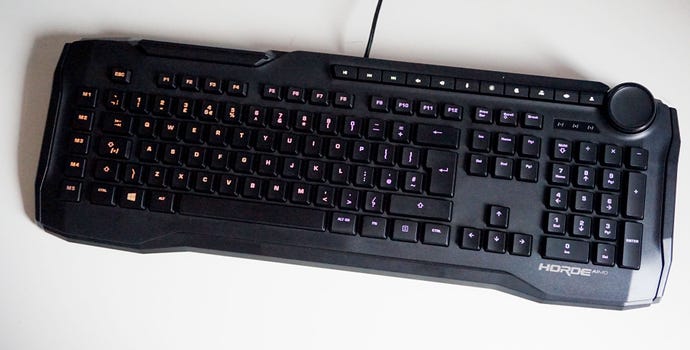
This spot was previously filled by the Asus TUF Gaming K5, but that has vanished from reputable retailer sites, so it’s safe to say Asus has taken it ‘round the back with a bolt gun. At least there’s a worthy replacement in the Roccat Horde Aimo, which like the K5 marries the affordability and quietness of membrane keyboards with the swiftness and precision of mechanical switches.
The Horde Aimo has another rare quality too: its multifunctional Dial. Lots of keyboards have a little volume wheel, but Roccat’s Dial can scroll through web pages and documents, zoom in on the screen, or even act as an undo/redo input. On top of this keyboard’s very capable gaming performance, the Dial also grants it an unusual degree of flexibility for everyday browsing and working.
Read more in our Roccat Horde Aimo review
AOC GK200
The best budget gaming keyboard
Pure membrane keyboards do have their benefits: they’re quiet and, especially in the case of the AOC GK200, much more affordable than their mechanical and hybrid cousins. The GK200 isn’t just here ‘cos it’s cheap, either: it distinguishes itself among entry-level gaming keyboards by actually making an attempt to replicate the snappiness of a premium model. It offers some tasty extras as well, in the form of spill resistance and a magnetic wrist rest.
Not that the faux-mechanical feel will fool anyone into thinking this is a genuine mech board, but just like the SteelSeries Apex 3 TKL, there’s a firmness here that makes the GK200 just that bit more satisfying to use than most membranes. There’s a decent amount of travel depth too, despite the whole thing bordering on a low profile design.
Logitech G915 Lightspeed Wireless
The best wireless gaming keyboard
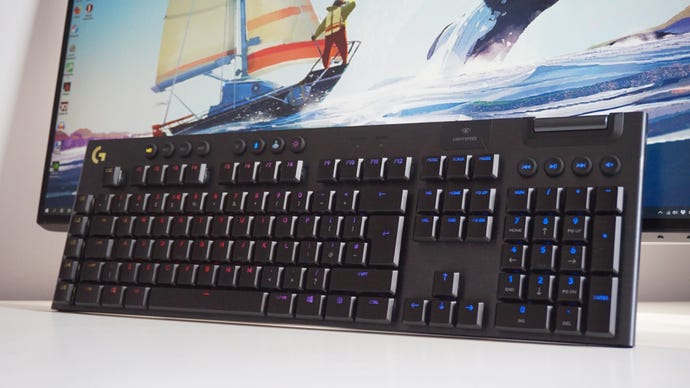
The Logitech G915 Lightspeed Wireless might be expensive, but by golly is it worth it. With its super slim aluminium frame, oleophobic key cap coating, gorgeous volume roller and dual-height adjustable feet, this is an outstanding piece of wireless gaming keyboard design.
Available in three different types of Logitech GL switches (clicky, tactile and linear), the G915 Lightspeed Wireless feels wonderful under your fingers, offering loads of tactile feedback and quick, sharp key presses. Logitech's Lightspeed tech means it feels super responsive as well; Katharine reported it feeling just like using a traditional wired keyboard. The clicky version we were sent for review wasn't too loud, either, making it nice and easy on the ears.
It's also got great battery life. Even after a couple of weeks use, the G915 only lost about 35% of its charge with its full RGB lighting going, so you could easily use this for an entire month without having to connect it back up to your PC. Even better, it only takes three hours to fully charge up again, and you get a warning when it gets down to 15% so you're not suddenly cut off mid-game.
Logitech has since launched a more compact tenkeyless version of the G915, too - the G915 TKL, giving you even more options when it comes to size. Plus, if the wireless version is out of your price range, there's a cheaper wired version that has exactly the same design called the Logitech G815 Lightsync, which is just as lovely and costs £116 / $170.
Read more in our Logitech G915 Lightspeed Wireless review
Corsair K70 Pro
The best optical-mechanical gaming keyboard
Optical-mechanical switches combine the keen feel of pure mech switches with the unbeatable speed of light-based actuation. As such, they’re ideal for games, and the Corsair K70 Pro is the best optical keyboard I’ve used to date.
It’s on the larger side, even for a full-sizer, but fills the space with extra lighting and media controls, and covers the rest with relatively rugged (and nicely textured) PBT keycaps. Naturally, it can easily keep pace in in speedy games like shooters, and although each key press has a noisier bottoming-out sound that you’d expect from a linear switch, it’s not pingy or piercing.
I don’t entirely like that having the K70 Pro here means booting the Razer Huntsman V2 off the list entirely, as that’s also a very fine keyboard with optical switches that manage to be sound-dampened without feeling mushy. But Corsair’s board is cheaper, comes with a few extra dedicated controls, and in my hands at least, feels slightly more robust.
Roccat Vulcan TKL Pro
The best tenkeyless gaming keyboard
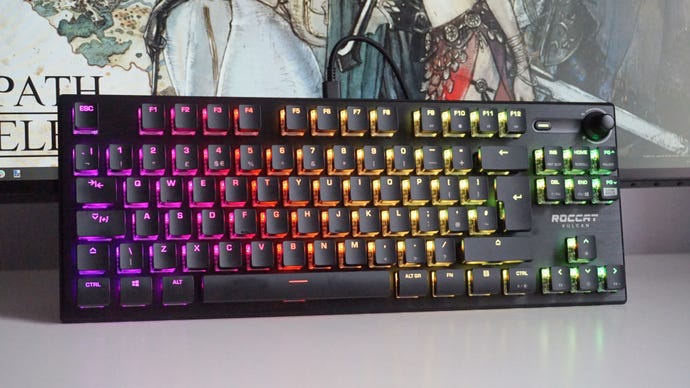
A condensed version of the original Roccat Vulcan, the Vulcan TKL Pro is another brilliant addition to Roccat's mechanical keyboard family. It chops off the number pad for a more compact form factor, but still retains the same great build quality and Roccat's fantastic Titan switches.
Roccat have opted for new optical versions of their proprietary Titan switch for the Vulcan TKL Pro, producing a much quieter gaming keyboard that doesn't grate on the ears. It will likely still drive friends and family up the wall if they're nearby, but not the same extent as conventional mech switches.
The Vulcan TKL Pro's smaller size doesn't mean it skimps on features, either, as you still get a lovely, tactile volume wheel and a dedicated microphone mute button. Roccat's Swarm software also lets you add a secondary function to practically every key on the keyboard, too, giving you plenty of customisation options. It's expensive, but if you're after the finest tenkeyless keyboard around, it doesn't get better than this. For a cheaper alternative, check out the SteelSeries Apex 3 TKL below.
Read more in our Roccat Vulcan TKL Pro review
SteelSeries Apex 3 TKL
The best cheap TKL gaming keyboard
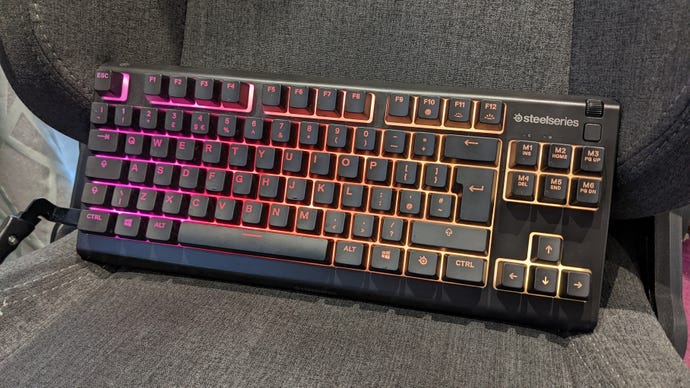
Other than its click-deprived membrane switches, the SteelSeries Apex 3 TKL is pretty decked out for a keyboard that’s both a) cheap and b) intentionally missing a chunk. For one thing it’s got a set of dedicated media keys, in the form of a pause/play button and a volume wheel (that also mutes when pressed down). On the gaming side specifically, there’s full N-key rollover and easy macro recording, with the navigation keys doubling up for macro button duty.
It will also shrug off spillages of water/tea/revolting energy drink of your choice, as it’s water-resistant to the IP32 standard. That’s not enough for it to survive sustained dunkage, but I ran it under a tap for a while and it soon dried off without ill effects, so half a glass of your beverage won’t faze it. The plastic liquid barrier happens to emphasise the RGB backlighting too: this lighting is even and adjustable, albeit only in zones rather than on a per-key basis.
Unexpectedly, I ended up liking the feel of the Apex 3 TKL as well. It obviously lacks the crispness and speed of a good mechanical board, but there’s a certain firm quality to the membrane switches that keeps each full press feeling more decisive than on most mushy rubber dome models.
MSI Vigor GK71 Sonic Blue
The best gaming keyboard with clicky switches
Mechanical switches with an intentionally loud click are usually thought of as a typist’s tool – the extra dash of audible feedback can help with bashing out paragraphs but has limited use in games, even if you don’t find it actively distracting. Even so, the MSI Vigor GK71 Sonic Blue shows that clicky switches aren’t just for work.
Not that this is a new concept, as there are loads of gaming keyboards that can be equipped with clicky switches like Cherry MX Blues. I’ve found myself preferring MSI’s Sonic Blue switches for gaming, though, owing to their smoother, faster feel. Their shorter travel distance and lower actuating force (45cn to the MX Blues’ 60cn) produce a sharper, more responsive feel that’s comfortably up to the task of controlling pacey games. There is more noise than with linear switches, but not enough to penetrate headphones.
Build quality is good too, with a nice aluminium plate on top, and the dedicated medica controls include a cute volume wheel that spins the mute button simultaneously. My only real complaint is that the default backlighting effects are far too flamboyant, though these are easily changed, either on the keyboard itself or on a per-key basis via the MSI Center software.
Ducky One 3 TKL
The best gaming keyboard with hot-swappable switches
The Ducky One 3 TKL has a whiff of the old-school about it, especially in its chunky chassis, but it’s really every bit the modern mechanical keyboard. That goes right down to the use of hot-swappable switches: with a puller tool you can painlessly yank out individual switches, not just the keycap on top, and just as easily slot in a different compatible switch. It’s a nicely beginner-friendly way of customising the feel and sound report of your keyboard without having to build one from scratch.
Not that the One 3 TKL doesn’t play well out of the box. If anything, comfort and tactility are two of its biggest successes: the two-step folding feet help find a pleasant typing angle, and the “frosted” matte finish of the thick, durable keycaps feels great. I went for Cherry MX Red switches on my test unit, which also provide a fluid, not overly noisy typing sensation, but loads of other Cherry switches can be equipped before you buy.
There are also multiple colour options, as well as full-size, 65% and 60% versions of the Ducky One 3, all with the same hot-swappable switch feature.
Roccat Vulcan II Mini
The best compact gaming keyboard
I love 65% form factor keyboards – they’re less space-hungry than even tenkeyless models, but still make room for dedicated arrow keys and a handful of navigation keys. My absolute favourite right how is the Roccat Vulcan II Mini, which shares the same agile-feeling half-height keycap design as its bulkier Vulcan cousins, while swapping in Roccat’s upgraded Titan II optical-mechanical switches.
These still trade travel depth for speed, so you’ll notice the shallower 1.4mm actuation distance if you’re more used to Cherry MX Reds or similar switches. But they really do feel lightning quick, and the Titan II iteration is a little smoother and fuller than the original Titan design. This new switch also makes room for secondary LEDs, which are put to good use on the Vulcan II Mini: hold down the Function key, and any key with a secondary input will glow a different colour. Doubling-up duties is a necessity on compact keyboards, so this is a nice touch that could help you acclimatise if you’re more used to full-size boards.
Corsair K70 Pro Mini Wireless
The best 60% gaming keyboard
There are cheaper 60% form factor keyboards than the Corsair K70 Pro Mini Wireless. I won’t lie: much cheaper ones. Fortunately, you’re not exactly paying more for less. Between its reliable wireless connectivity, hot-swappable mechanical switches, nicely textured keycaps, full RGB lighting, extensive macro support, media controls, and N-key rollover, it’s an impressively robust gaming keyboard that matches plenty of larger alternatives on features.
Personally, I’m too reliant on arrow keys to permanently convert to a 60% model, but there’s just something comfortable about using the K70 Pro Mini Wireless. It doesn’t feel too cramped for typing (especially with that full-height Enter key, which not all 60% keyboards have) and despite having both mechanical keys and a battery adding weight, it’s as light as a wireless keyboard should be. The unit I tested came with Cherry MX Red switches, which feel fast and stable, though you can swap these any time – and on a per-key basis – if you want to try customising the feel and sound report.
For a more affordable 60% alternative, the HyperX Alloy Origins 60 is another good’un. It lacks hot-swappable switches but they’re still fully mechanical, and the build quality is as good as that of the K70 Pro Mini Wireless. It usually goes for around £90 / $70.
Asus ROG Strix Flare II Animate
The best RGB gaming keyboard

You can’t miss the Asus ROG Strix Flare II Animate: it’s got more lights on it than Piccadilly Circus, most of which are the fully customisable RGB backlighting variety. Meanwhile, the “Animate” part comes from a brand new addition, the angled dot matrix display in the corner, which you can personalise with text, images and animations of your choosing. It’s not what you’d call tastefully reserved, but it’s easier to make your own than the acrylic insert on the original ROG Strix Flare.
Other improvements include a thinner, more modern-looking chassis, a padded wrist rest, and the same style of easily hot-swappable mechanical switches as the Ducky One 3 TKL above. Not that there’s anything wrong with the linear Asus NX Red switches that come by default – they’re smooth and fast but with just a hint of firmness, and provide good audio feedback without the shrillness of a tactile click. The ROG Strix Flare II Animate is also lined with foam, which successfully prevents the dinging sound that some mech boards produce when a key is fully depressed.
Media controls, USB 2.0 pass-through, and on-the-fly macro recording further fill out the features list on an already multitalented keyboard. Far more customisations (and RGB syncing settings) are available within the ROG Armoury Crate software, though this is one area that still needs some work; it's not terribly easy to navigate.
Logitech G413 SE
The best cheap mechanical gaming keyboard
Truly cheap mechanical keyboards are rare, so it’s always nice to see efforts like the Logitech G413 SE. This does jettison quite a few of the original G413’s premium features, including macro recording, but the result is an affordable, clean-looking mech board that’s more than capable in most games. In fact, I used it as my main keyboard for several weeks.
The switches are tactile, with a subtle bump at the actuation point, but they don’t click so loudly as to distract or penetrate through headphones – a good combination for games and everyday typing alike. 6-key rollover is also enough to handle speedy WASD-slamming without delays, and the chunky keycaps avoid the overly delicate feel of some lower-priced keyboards. There’s no audible metallic pinging/resonance to keypresses either, a common design flaw that can annoy even on much more expensive mech models.
If you want RGB lighting (the G413 SE’s backlight is solid white) or more dedicated media controls, the Roccat Pyro is a good alternative, but I generally prefer Logitech’s more mature, closely-trimmed design. Especially with the nice slab of brushed aluminium on top.
How to choose the right gaming keyboard
Membrane or mechanical?
The first thing you need to decide is whether you want a mechanical gaming keyboard or a membrane one. Generally, mechanical keyboards are better for gaming due to their fast, clean movements and their short actuation points (that's when the keyboard actually registers you've pressed down a key). They are, however, more expensive, often commanding prices of at least £100 / $120 if not significantly more. They're more durable than membrane keyboards, though, and are (in theory) easier to repair as you only need to replace the individual switch instead of chucking out the entire keyboard.
Membrane keyboards, on the other hand, are usually a lot quieter and cheaper than their mechanical counterparts because they're made from less expensive materials. However, his in turn makes them more prone to breaking and are generally a bit of a pain to fix. Given their low price, it's often easier to just to buy a brand-new one.
Mechanical keyboard switches explained
If you do decide to opt for a mechanical keyboard, the next thing to decide is what type of switch you want. Most gaming keyboards tend to use the German-made Cherry MX switches, but you'll occasionally see other types from Kailh and Outemu, or in the case of Logitech and Razer, their own in-house switches. Broadly speaking, though, they tend to fall into one of two categories: linear or tactile.
Taking Cherry's MX switches as our primary example, linear Red switches are often considered the fastest and best for gaming. Their simple, unaltered up and down movements don't provide a lot of tactile feedback, making them less suitable for long typing stints, but their short actuation points make them a good choice for FPS games and competitive online games. There are also MX Speed Silver switches, which have an even shorter actuation point than MX Reds.
Tactile Blue switches, on the other hand, are generally better suited for typing thanks to their loud and clicky sound, while Brown switches are a sort of halfway house between Red and Blues. They're a bit quieter than other switch types, but when you press them you'll often feel a small bump halfway down, giving you a bit more physical confirmation that you've pressed a key correctly.
We're also starting to see more Kailh or Kaihua switches appear on mechanical keyboards, too. These are made in China and the most common linear models are Kailh Reds, which are very similar to Cherry MX Reds, and Speed Silvers, which as you might have guessed is Kailh's answer to Cherry's MX Silver. You'll also find tactile Kailh Browns and Blues, but they've got a few more tactile 'Speed' variants, too, including Speed Bronze and Speed Copper. These are less common, but are a lot more 'clicky' (i.e.: noisy) than their linear Speed Silver counterparts.
Outemu switches are also made in China, and again, largely correspond to what you'll find in the Cherry MX camp. They're generally found in budget gaming keyboards and come in very similar colours: Red, Blue, Brown, and Black. Outemu Black switches are linear, like Reds, but have a much heavier actuation force, so you'll need to press it down harder in order for a keystroke to register.
Razer, on the other hand, have a completely different colour scheme to Cherry, Kailh, and Outemu. They only have one linear type (Yellow) and two tactile types (Green and Orange). Yellows are closest to Cherry's MX Speed Silver switches, while Greens are effectively the same as Cherry MX Blues. Orange, meanwhile, are Razer's answer to MX Brown switches.
As for Logitech, their naming convention is much easier to understand. While they all include the name 'Romer-G', they're usually described as either Romer-G Linear or Romer-G Tactile. Simple.
An increasing variety of gaming keyboards now include hot-swappable mechanical switches, so if you decide you don't like the feel or sound of the default switches, you can remove and replace them yourself with a simple puller tool and no need to open up the chassis of the keyboard itself. Switches don't universally fit every hot-swap-compatible keyboard, but a lot of Cherry and Kailh switches will fit into the same socket, you'll have plenty of choice. You'll have to find and pay for replacement switches yourself, mind.
